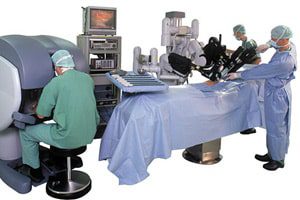
Robotic surgery marketing appears to be tied to robotic surgery injury reports, according to a new report concerning the da Vinci robotic surgical system that is manufactured and marketed by Intuitive Surgical. In one case highlighted by Bloomberg.com, general surgeon Warren Kortz, who had been on staff at Porter Adventist Hospital in Denver, was the […]
 Robotic surgery marketing appears to be tied to robotic surgery injury reports, according to a new report concerning the da Vinci robotic surgical system that is manufactured and marketed by Intuitive Surgical.
Robotic surgery marketing appears to be tied to robotic surgery injury reports, according to a new report concerning the da Vinci robotic surgical system that is manufactured and marketed by Intuitive Surgical.
In one case highlighted by Bloomberg.com, general surgeon Warren Kortz, who had been on staff at Porter Adventist Hospital in Denver, was the first in that area to use robotic surgery to remove gall bladders. The hospital described the technology as “taking advantage of another breakthrough in robotic surgery” that is “easier on the patient,” according to its press release. In another article released by the hospital, Kortz described the technology as, “It’s Star Wars stuff … My prediction is it will eventually replace everything else.” Risk was not discussed.
While Kortz and the hospital touted the robotic surgery, 10 of Kortz’ patients suffered injuries or complications in the period 2009-2011, according to an April complaint made by the Colorado Medical Board. Of those, five suffered either punctured or torn arteries, two had items temporarily left inside of their bodies, two suffered nerve damage, one died, and one required cardiopulmonary resuscitation, according to Bloomberg.com. The complaint charges the surgeon with 14 counts of unprofessional conduct, including not always advising patients on alternatives to robotic surgery.
Robot operations have never been proven in randomized trials to offer significant health benefits when compared to standard surgeries, according to Bloomberg.com. In fact, a number of studies have found that robot surgeries are much more costly. And, while Intuitive has been faulted for not offering sufficient training, they are known for aggressive marketing. “If there was a Nobel Prize for marketing, it would go to Intuitive Surgical,” John Mulhall, an urologist at Memorial Sloan-Kettering Cancer Center in New York, told Bloomberg.com
Peter Dunn, executive medical director for perioperative services at Massachusetts General Hospital, said Intuitive Surgical sales reps “were constantly coming in” pitching the ways in which the hospital could form a partnership with Intuitive by providing robot training, holding symposiums on robot surgery, or advertising the benefits of the da Vinci. “They would go to any avenue they could to infiltrate Mass General,” Dunn, who declined the partnership, told Bloomberg.com. “We absolutely refused.” Intuitive’s marketing “has pushed the limits of truth,” Dunn noted, pointing out that the hospital does use the da Vinci, but, “sparingly” and only for urology and gynecology procedures.
Once a hospital purchases a da Vinci, Intuitive provides what Bloomberg.com describes as “an extensive marketing kit.” Marketing materials for robotic hysterectomy have included “cherry-picked and very misleading information,” Barbara Levy, vice president for health policy at the American Congress of Obstetricians and Gynecologists, told Bloomberg.com.
A study conducted last year by Columbia University researchers found that 44 percent of hospital web sites pushed robot gynecology surgery; just 1.6 percent discussed possible complications. Web sites for hospitals conducting robotic prostate surgery for erectile dysfunction have often have included unproven claims of superiority, according to a Memorial Sloan-Kettering study. And, noted Bloomberg.com, many sites included “generic information copied directly from the web site of Intuitive Surgical,” the 2010 study also found. Another study, conducted by Johns Hopkins School of Medicine researchers and published in 2011 in the Journal for Healthcare Quality, revealed that 164 hospital robot surgery web sites surveyed “overestimate benefits, largely ignore risks, and are strongly influenced by the manufacturer.”
Scores of deaths have been tied to the da Vinci since 2009 and personal injury lawsuits brought over the device allege severe internal injuries such as burns, tears, and other complications; allegations assert that some procedures caused chronic pain, disability, or death. Lawsuits also accuse Intuitive’s aggressive marketing practices and allege that design flaws inherent in the da Vinci, as well as poor physician training on the device, are to blame.


